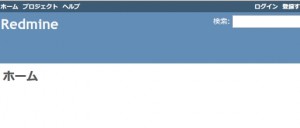ちょっとだけこなれてきたのでwordpressに続いて、今度はわりと自力でredmineのDocerfileを作ってみた。イメージならDocker Hubにあるんだけど、やっぱりエンジニアを目指すなら自分で作ってみたいじゃない。
CentOSにredmineを入れるHow to で、手順のベースにしたサイトはこちら
今回ももちろん色々とググって試行錯誤しながら作ったんだけど、見ているのが自分のサイトと気づかずに自分のサイトを読んでいたマヌケちゃんは今回が初めてかも・・・。
試行錯誤のようなDockerfileなので見た目とかプロトタイプ的なところはありますが、とりあえず公開。
環境から
$ cat /etc/os-release NAME=CoreOS ID=coreos VERSION=386.1.0 VERSION_ID=386.1.0 BUILD_ID= PRETTY_NAME="CoreOS 386.1.0" ANSI_COLOR="1;32" HOME_URL="https://coreos.com/" BUG_REPORT_URL="https://github.com/coreos/bugs/issues"
$ docker version Client version: 1.1.1 Client API version: 1.13 Go version (client): go1.2 Git commit (client): dc62f3c Server version: 1.1.1 Server API version: 1.13 Go version (server): go1.2 Git commit (server): dc62f3c
Dockerfile
$ cat docker-redmine/conf/Dockerfile FROM centos:centos6 MAINTAINER takeken # yum + repo RUN yum install -y wget RUN yum install -y sudo tar openssh openssh-clients openssh-server syslog httpd httpd-devel mysql-server vim python-setuptools RUN sleep 60 RUN wget http://rpms.famillecollet.com/enterprise/remi-release-6.rpm ;\ wget http://dl.fedoraproject.org/pub/epel/6/x86_64/epel-release-6-8.noarch.rpm ;\ wget http://pkgs.repoforge.org/rpmforge-release/rpmforge-release-0.5.3-1.el6.rf.x86_64.rpm ;\ rpm -ivh epel-release-6-8.noarch.rpm remi-release-6.rpm rpmforge-release-0.5.3-1.el6.rf.x86_64.rpm RUN yum --enablerepo=remi,epel groupinstall -y "Development Tools" RUN yum --enablerepo=remi,epel,centosplus install -y openssl-devel readline-devel zlib-devel curl-devel libyaml-devel ImageMagick ImageMagick-devel ipa-pgothic-fonts mysql-devel # ssh RUN sed -ri 's/UsePAM yes/#UsePAM yes/g' /etc/ssh/sshd_config RUN sed -ri 's/#UsePAM no/UsePAM no/g' /etc/ssh/sshd_config RUN ssh-keygen -t rsa -f /etc/ssh/ssh_host_rsa_key RUN ssh-keygen -t dsa -f /etc/ssh/ssh_host_dsa_key RUN useradd takeken RUN echo 'takeken:takeken' | chpasswd RUN echo 'takeken ALL=(ALL) NOPASSWD:ALL' >> /etc/sudoers.d/takeken # ruby RUN curl http://cache.ruby-lang.org/pub/ruby/2.0/ruby-2.0.0-p451.tar.gz | tar -xz -C /tmp RUN cd /tmp/ruby-2.0.0-p451 ; ./configure --disable-install-doc && make && make install RUN cd /tmp/ruby-2.0.0-p451/ext/openssl ; ruby extconf.rb ; make ; make install RUN cd /tmp/ruby-2.0.0-p451/ext/zlib ; ruby extconf.rb ; make ; make install RUN gem install bundler --no-rdoc --no-ri # setting # RUN sed -ri "s/^SELINUX=enforcing/SELINUX=disabled/" /etc/sysconfig/selinux # supervisor RUN easy_install supervisor RUN echo_supervisord_conf > /etc/supervisord.conf RUN echo '[include]' >> /etc/supervisord.conf RUN echo 'files = supervisord.d/*.conf' >> /etc/supervisord.conf RUN echo '[inet_http_server]' >> /etc/supervisord.conf RUN echo 'port=0.0.0.0:9001' >> /etc/supervisord.conf RUN echo 'username=takeken' >> /etc/supervisord.conf RUN echo 'password=takeken' >> /etc/supervisord.conf RUN mkdir -p /etc/supervisord.d ADD set.conf /etc/supervisord.d/set.conf #mysql RUN service mysqld restart && \ /usr/bin/mysqladmin -uroot password takeken RUN service mysqld restart && \ mysql -uroot -ptakeken -e "CREATE DATABASE redmine; GRANT ALL PRIVILEGES ON redmine.* TO 'redmine'@'localhost' IDENTIFIED BY 'redmine'; FLUSH PRIVILEGES;" # redmine RUN curl http://www.redmine.org/releases/redmine-2.5.0.tar.gz | tar -xz -C /tmp RUN mv /tmp/redmine-2.5.0 /var/lib/redmine RUN mkdir -p /var/lib/redmine/config ADD configuration.yml /var/lib/redmine/config/configuration.yml ADD database.yml /var/lib/redmine/config/database.yml RUN cd /var/lib/redmine ; bundle install --without development test postgresql sqlite ;\ RAILS_ENV=production bundle exec rake db:migrate ;\ gem install passenger --no-rdoc --no-ri ;\ bundle install ADD passenger.conf /etc/httpd/conf.d/passenger.conf RUN sed -ri 's_DocumentRoot.*_DocumentRoot /var/lib/redmine/public_' /etc/httpd/conf/httpd.conf RUN passenger-install-apache2-module --auto RUN service mysqld restart RUN cd /var/lib/redmine ; bundle exec rake generate_session_store ; bundle exec rake generate_secret_token ; bundle install RUN sleep 60 RUN /etc/init.d/mysqld start && cd /var/lib/redmine ; bundle exec rake db:migrate RAILS_ENV=production ;\ rake tmp:cache:clear ; rake tmp:sessions:clear RUN chown -R apache:apache /var/lib/redmine EXPOSE 22 80 9001 CMD ["/usr/bin/supervisord"]
configuration.yml
$ cat docker-redmine/conf/configuration.yml production: email_delivery: delivery_method: :smtp smtp_settings: address: "localhost" port: 25 domain: 'example.com' rmagick_font_path: /usr/share/fonts/ipa-pgothic/ipagp.ttf
database.yml
$ cat docker-redmine/conf/database.yml production: adapter: mysql2 database: redmine host: localhost username: redmine password: redmine encoding: utf8
passenger.conf ※これは時期とか環境によって変わるはずです。
$ cat docker-redmine/conf/passenger.conf LoadModule passenger_module /usr/local/lib/ruby/gems/2.0.0/gems/passenger-4.0.48/buildout/apache2/mod_passenger.so <IfModule mod_passenger.c> PassengerRoot /usr/local/lib/ruby/gems/2.0.0/gems/passenger-4.0.48 PassengerDefaultRuby /usr/local/bin/ruby </IfModule>
set.conf
$ cat docker-redmine/conf/supervisor.conf [supervisord] nodaemon=true [program:sshd] command=/usr/sbin/sshd -D autostart=true autorestart=true [program:httpd] command=/usr/sbin/httpd -D FOREGROUND autostart=true autorestart=true #command ha docchika ?? [program:mysqld] command=/usr/bin/pidproxy /var/run/mysqld/mysqld.pid /usr/bin/mysqld_safe --datadir=/var/lib/mysql --socket=/var/lib/mysql/mysql.sock --pid-file=/var/run/mysqld/mysqld.pid --basedir=/usr --user=mysql #command=/usr/bin/mysqld_safe --datadir=/var/lib/mysql --socket=/var/lib/mysql/mysql.sock --pid-file=/var/run/mysqld/mysqld.pid --basedir=/usr --user=mysql autostart=true autorestart=true
相変わらずセキュリティ面はあまり考慮していないので、あくまでベースとして使ってください。
起動してアクセスするとこの画面になります。
$ docker run -p 80:80 -p 22 -p 9001 -d take/red /usr/bin/supervisord 0d82ad5a75c902d05dd9d2b59482cb40503a4214b3644e7db724e907a08f4152
デフォルトなので、ログイン・パスワードともにadminです。
あいかわらずrubyは知らないけど、これでredmineもお手軽に使えますね。
じゃねー。

Dockerfile参考にさせてもらってます。
45行目の set.conf は supervisor.conf ですかね。
あと
https://github.com/docker/docker/issues/1554
にあるみたいに、DockfileにHEREDOCが書けたら嬉しいですよね。
(38~43行目みたいなところが一瞬で終わるので)
いつかDocker側が対応してくれたらいいなぁと思います。
今は /tmp に ADD してcat tmp.txt >> /etc/superviser.conf みたいな方法しか思いつきませんでした。
このDockerfileのままだと、Mysqlのdbがlatinで作られて日本語が化けました。
#新規プロジェクトの”説明”に日本語を入れたりすると、文字化けします。
色々調べてみると、こんな風に解決するのがデフォみたいです。
http://linuxserver.jp/%E3%82%B5%E3%83%BC%E3%83%90%E6%A7%8B%E7%AF%89/db/mysql/%E6%96%87%E5%AD%97%E5%8C%96%E3%81%91%E8%A7%A3%E6%B6%88.php
てことで、うちで試したときは Dockerfile を一部修正させてもらって
% diff Dockerfile.original Dockerfile
47a51,53
> RUN mkdir -p /etc/mysql.d
> ADD files/my_additional.cnf /etc/mysql.d/my_additional.cnf
> RUN echo ‘!includedir /etc/mysql.d’ >> /etc/my.cnf
で、my_additional.cnf に
[client]
default-character-set=utf8
[mysql]
default-character-set=utf8
[mysqld]
skip-character-set-client-handshake
character-set-server = utf8
collation-server = utf8_general_ci
init-connect = SET NAMES utf8
と書いておくと、日本語で説明を書いても上手くいきました。
こちらからは以上です。
らささべさん
>#新規プロジェクトの”説明”に日本語を入れたりすると、文字化けします。
わー、ほんとですね(泣)プロトタイプとしても、これは詰めが甘い・・・(´・ω・`)
情報ありがとうございます。
HEREDOCの変わりの/tmpからリダイレクトするテクニックは素晴らしいですね。
公開するのは一時の恥という事で、精進します。
コメントありがとうございました。(^^)